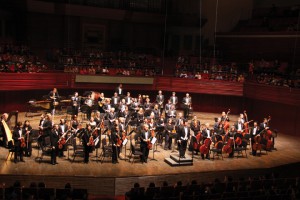The Park Avenue Chamber Symphony in Review
The Park Avenue Chamber Symphony in Review “Majestic Finale” David Bernard, Music Director All Saints Church, New York, NY May 6, 2012
A large and very enthusiastic audience was on hand for this, the final concert of the Park Avenue Chamber Symphony’s 2011/12 season. They were treated to an exemplary performance of Beethoven’s Symphony No.4 in B flat major, Opus 60, and were thrilled by the visceral climaxes of Mahler’s Symphony No 1 in D major (“Titan”.) One might ask what a Mahler symphony is doing on a program by a performing organization which has “chamber symphony” in its name. My answer is that one of the glories of Mahler’s use of the orchestra is that no matter how large a performing group he writes for, the scoring is often that of a chamber orchestra, with long quiet passages for solo instruments interspersed between passages for very, very full orchestra. In addition, this Beethoven/Mahler combination was an inspired pairing; as both works have similarly mysterious pianissimo openings.
Conducting without a score, Maestro Bernard led his players in an assured, beautifully shaped and well-paced performance of the Beethoven. The tempi he chose allowed the music to unfold naturally. We heard none of the very, very fast or very, very slow tempi which so many conductors now choose perhaps to show us an “original” interpretation of a well-known work. Readers of the New York Concert Review might remember that I am very insistent that performers obey the composer’s instructions and observe all of the indicated repeats. I am happy to report that this afternoon all of Beethoven’s repeats were performed. And so were those in the Mahler!
The very live acoustics of All Saints Church caused a problem which persisted throughout the concert; the solo winds, when playing passages marked piano, all sounded too loud. I’m sure that the players were following Beethoven’s dynamic marking, but the contrast between loud and soft didn’t come across. As this was not the case with the strings, the tutti crescendi, so crucial in a work by Beethoven, were handled beautifully.
After intermission came the Mahler. Again conducting without a score, Maestro Bernard led the huge orchestra with discrete, clear and concise gestures. The orchestral playing was of the same high quality we heard on the program’s first half. The strings were especially impressive – the wild opening of the last movement was played with confident abandon. The horns, all seven of them, had a very high batting average. It was a very impressive performance. But for this listener, during the lyrical passages there was something missing, and it is hard to put it into words without sounding too negative, something I do not wish to do as it would seem to contradict the statement which precedes this sentence. So with that disclaimer, I’ll try. I found the lyrical section somewhat stiff and careful, with little of the warmth and disciplined freedom I look for in a Mahler symphony. A bit more use of portamento in the strings would have also been welcome. But when the orchestra was going at full tilt, all was well. And when it was over, the audience rose to their feet and thanked the performers with heartfelt applause and cheers.

